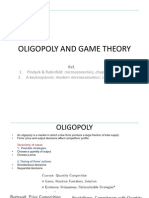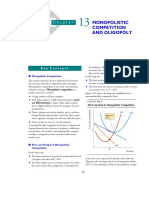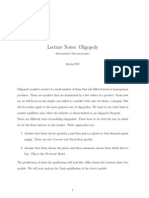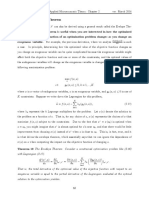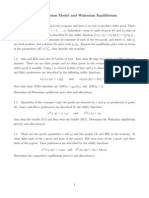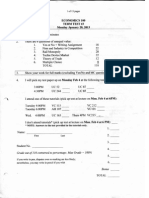Department of Economics: ECO 204 Microeconomic Theory For Commerce 2013 - 2014 Test 1 Solutions
Department of Economics: ECO 204 Microeconomic Theory For Commerce 2013 - 2014 Test 1 Solutions
Uploaded by
examkillerCopyright:
Available Formats
Department of Economics: ECO 204 Microeconomic Theory For Commerce 2013 - 2014 Test 1 Solutions
Department of Economics: ECO 204 Microeconomic Theory For Commerce 2013 - 2014 Test 1 Solutions
Uploaded by
examkillerOriginal Title
Copyright
Available Formats
Share this document
Did you find this document useful?
Is this content inappropriate?
Copyright:
Available Formats
Department of Economics: ECO 204 Microeconomic Theory For Commerce 2013 - 2014 Test 1 Solutions
Department of Economics: ECO 204 Microeconomic Theory For Commerce 2013 - 2014 Test 1 Solutions
Uploaded by
examkillerCopyright:
Available Formats
Page 1 of 32
Department of Economics ECO 204 Microeconomic Theory for Commerce 2013 - 2014
Test 1 Solutions
IMPORTANT NOTES:
Proceed with this exam only after getting the go-ahead from the Instructor or the proctor
Do not leave during the first hour of the exam or the last 15 minutes of the exam
You are not allowed to leave the exam room unattended. If you need to go to the washroom, please raise your hand and a
proctor will accompany you to the washroom. You are allowed to go to the washroom ONLY.
You are required to stop writing and turn your exam face down when asked to stop by the instructor or proctor at the end of
the exam
Please note that proctors will take down your name for academic offenses, which will be treated in accordance with the policies as
published by the Faculty of Arts and Sciences.
Exam details:
Duration: 2 hours and 20 minutes
Total number of questions: 9 (see next page of test for breakdown of points)
Total number of pages: 32 (including title page)
Total number of points: 100
Please answer all questions. To earn credit you must show all calculations.
Exam aids:
This is a closed note and closed book exam.
You may use a non-programmable calculator. Sharing is not allowed.
University of Toronto Academic Code of Conduct:
The Universitys Code of Behavior on Academic Matters (Code) applies to all Rotman Commerce students. The Code prohibits all forms of
academic dishonesty including, but not limited to, cheating, plagiarism, working on the exam after the proctor has announced the exam
has ended and the use of unauthorized aids. Students violating the Code may be subject to penalties up to and including suspension or
expulsion from the University.
By signing my name and entering my name and student number, I am confirming that I have read and understand the Universitys Code of
Behavior on Academic Matters. I will conduct myself with the utmost integrity and I will neither give nor receive unauthorized aid in tests or
examinations.
Please provide the following information. Tests without the following information will NOT be graded.
Please circle the section in which you are registered
(not necessarily the same as the section you attend)
Mon 1 3
L0101
Tue 11 1
L0102
Tue 2 4
L0103
Wed 6 8
L5101
Signature
PRINT your
Last Name
PRINT your
First Name
9or 10 Digit
Student ID #
For use by Proctors only
Page 2 of 32
THIS TABLE IS FOR GRADERS USE ONLY
PAGES 3 11: SHORT QUESTIONS
TOTAL POINTS FOR SHORT QUESTIONS 31
SHORT QUESTION MAXIMUM POINTS SCORE COMMENTS
1 11
2 3
3 5
4 3
5 9
PAGES 12 33: LONG QUESTIONS
TOTAL POINTS FOR LONG QUESTIONS 69 + 2 BONUS
LONG QUESTION MAXIMUM POINTS SCORE COMMENTS
1 17
2 19
3 15 + 2 BONUS
4 18
TOTAL SCORE OUT OF 100 POINTS
GOOD LUCK!
KEEP YOUR ANSWERS AS BRIEF AS POSSIBLE AND SHOW ALL NECESSARY CALCULATIONS
Page 3 of 32
SHORT QUESTIONS
Short Question 1 [11 POINTS]
The following function is defined on the domain [ ):
()
Here are parameters.
(a) [2 POINTS] For what values of is this function concave? Show all necessary calculations.
(b) [2 POINTS] Assume . Solve the following problem:
()
Show all necessary calculations.
Page 4 of 32
(c) [2 POINTS] Calculate the change in
due to a small change in the parameter Show all necessary calculations.
(d) [5 POINTS] Calculate the change in
due to a small change in the parameter by two separate methods. Show all
necessary calculations.
Page 5 of 32
Short Question 2 [3 POINTS]
Consider the following general inequality constrained optimization problem:
()
Here is a constant and the function () is defined on the domain [ ). Your friend Crak-Bob attempts to
solve this problem by setting it up as follows:
()
() [ ]
()
[ ]
[ ]
Has Crak-Bob set up this problem correctly? If so, interpret if not, then set up but do not solve the problem
correctly. Show all necessary calculations.
Page 6 of 32
Short Question 3 [5 POINTS]
Consider the following inequality constrained optimization problem:
()
Here is a constant and the function () is defined on the domain [ ). Prove that that the optimal value of the
Lagrange multiplier
equals
(
Show all necessary calculations.
Page 7 of 32
Page 8 of 32
Short Question 4 [3 POINTS]
Consider the UMP:
The utility function is defined on the consumption set {(
) }. Assume that both goods are good goods.
True or false: the optimal quantities
from the UMP above will be identical to the optimal quantities
from
the UMP below:
Give a very brief explanation.
Page 9 of 32
Short Question 5 [9 POINTS]
(a) [3 POINTS] A consumer perceives two goods to be good goods and prefers to consume them as complements.
She prefers to consume four units of good 2 for every two units of good 1. Write down at least three utility functions
which represent this consumers preferences. Show all necessary calculations.
Page 10 of 32
(b) [3 POINTS] Suppose
and . What is the price of a unit of a good 1 and good 2
bundle/combo for the consumer in part (a)?
Page 11 of 32
(c) [3 POINTS] Now suppose that, perhaps due to persuasive advertising for good 2, the consumer likes good 2 more
than before. True or false: if her utility function was initially (
), then we can represent her greater
affinity for good 2 by a utility function with a higher value of and/or a lower value of ? Give a brief explanation.
Page 12 of 32
LONG QUESTIONS
Long Question 1 [17 POINTS]
The following demand function for a brand of soda sold across seven stores of a (monopoly) supermarket chain was
estimated from actual supermarket scanner data:
898 797
Here
quantity of soda (000s ozs.) and
average price per oz. of soda sold per week across all seven stores of
the supermarket chain. Currently,
7
(a) [10 POINTS] Suppose that the government has proposed imposing a 2% excise tax on all soda sold in this
supermarket chain. Calculate the potential impact on the representative soda consumers utility due to the proposed
2% excise tax. Show all necessary calculations and state all necessary assumptions. Provide all numerical answers to 4
decimal places.
Page 13 of 32
Page 14 of 32
(b) [3 POINTS] True or false: if instead of imposing an excise tax on soda, the government were to tax the supermarkets
(soda) customers income, the income tax would not impact the quantity of soda sold? Show all necessary calculations
and state all assumptions.
Page 15 of 32
(c) [4 POINTS] True or false: in general, a flat income tax is less bad for consumers than an excise tax on good 2 that is
designed to raise the same amount of tax revenue dollars as the flat income tax? Show all necessary calculations.
Assume both goods are good goods.
Page 16 of 32
Page 17 of 32
Long Question 2 [19 POINTS]
(a) [3 POINTS] When faced with the budget constraint
) a customer chooses bundle A = (
):
Now suppose that the price of good 1 falls from
to
so that the consumer now faces the budget constraint
) where
. Faced with this budget constraint, suppose the consumer chooses bundle C = (
):
)
C
A
The total price effect of good 1 due to its lower price is:
. To isolate the total substitution and total
income effects, we imagine taking away income from
) until the original bundle A once again becomes
affordable this yields the budget constraint
) where
.
Explain why the optimal choice bundle B = (
) on the budget constraint
) cannot be to the left of
bundle A. Put another way, briefly explain why the total substitution effect of good 1 due to its lower price must be ,
i.e.
)
A
Page 18 of 32
)
C
A
)
B
Page 19 of 32
(b) [4 POINTS] In part (a), we saw that in order to isolate the substitution and income effects, starting at budget
constraint
) we imagine taking away income until the original bundle A becomes affordable this yields
the budget constraint
) where
. Derive an expression for
in terms of
and
Show all
necessary calculations.
Page 20 of 32
(c) [4 POINTS] [THIS PART IS INDEPENDENT OF ALL REMAINING PARTS BELOW]
Evaluate these statements separately:
True or false: a Giffen good must be an inferior good.
True or false: an inferior good must be a Giffen good.
Give a brief explanation.
Page 21 of 32
(d) [8 POINTS] Suppose that a consumer has the utility function:
(
)
Suppose that initially
) ( ) and then
) ( ). Calculate the
total price, substitution and income effect on good 1.
Page 22 of 32
Page 23 of 32
Long Question 3 [15 POINTS]
Ajaz and Michelle live for exactly two days ( ) and are addicted to the game Call of Duty (just as Rob Ford is
addicted to crack). To keep their gaming addiction under control, the game keeper gives Ajaz and Michelle one token
on each day specifying the maximum number of hours that Ajaz and Michelle can play Call of Duty on that day. Let
and
be the number of hours written on their tokens and let
and
be the number of hours of Call of Duty they
choose to play on day 1 and day 2 respectively.
Ajazs utility for gaming is:
Michelles utility for gaming is:
Their endowments of tokens are both fixed at 5 hours per day, i.e.
.
Ajaz and Michelle are the only two people in this game and they can choose to trade tokens with each other. Currently,
the real interest rate in this gaming economy is .
(a) [1 POINTS] Suppose that there is one saver and one borrower in this gaming economy. Without doing any
calculations, explain who will save and who will borrow? Give a brief explanation.
Page 24 of 32
(b) [8 POINTS] At the current interest rate, how many hours will Ajaz and Michele consume and save? Write down your
answers in the table below. Show all necessary calculations. Provide numerical answers to 4 decimal places. Hint: You
dont have to derive expressions for
by setting up and solving the Inter-temporal Cobb-Douglas UMP. Instead, you
can modify the following expressions from consumer theory Cobb-Douglas UMP:
Page 25 of 32
(c) [1 POINTS] According to your calculation above, is the current interest rate in this gaming economy too high, too
low, or just fine? Show all necessary calculations.
Page 26 of 32
(d) [5 POINTS] Draw Ajazs inter-temporal UMP problem on to the following graph and show the consumption and
endowment points, the equilibrium indifference curve, and net savings over the two periods.
Page 27 of 32
(e) BONUS [2 POINTS] Calculate the equilibrium real interest rate at which Ajazs savings equal Michelles borrowings.
Show all necessary calculations. Provide numerical answers to 4 decimal places.
Page 28 of 32
Long Question 4 [18 POINTS]
(a) [3 POINTS] Consider the following general UMP:
The utility function is defined on the consumption set {(
) } Show that if goods 1 and 2 are good goods
then expenditure must equal income. Show all necessary calculations.
Page 29 of 32
If the consumer likes at least one good then shell expend her entire income (budget).
(b) [15 POINTS] Consider the following general UMP:
The utility function is defined on the consumption set {(
) } Assuming that goods 1 and 2 are good goods
solve this general UMP and derive conditions and solutions for all possible cases. Show all necessary calculations.
Page 30 of 32
Page 31 of 32
Page 32 of 32
You might also like
- Mgeb02 FinalDocument4 pagesMgeb02 FinalexamkillerNo ratings yet
- Consumer and Firm Behavior: The Work-Leisure Decision and Profit MaximizationDocument23 pagesConsumer and Firm Behavior: The Work-Leisure Decision and Profit MaximizationRachit BhagatNo ratings yet
- Regular Exam Jan - SolsDocument3 pagesRegular Exam Jan - SolsErmita YusidaNo ratings yet
- EC2101 Practice Problems 10 SolutionDocument3 pagesEC2101 Practice Problems 10 Solutiongravity_coreNo ratings yet
- Preliminary Draft Subject To Revision: Advanced Microeconomics I: Syllabus GECO 6200Document23 pagesPreliminary Draft Subject To Revision: Advanced Microeconomics I: Syllabus GECO 6200popov357No ratings yet
- ECON 101 Final Practice1Document32 pagesECON 101 Final Practice1examkillerNo ratings yet
- Manegerial EconomicsDocument97 pagesManegerial EconomicsSanjay KumarNo ratings yet
- University of Toronto - ECO 204 - Summer 2012 - : Department of Economics Ajaz HussainDocument36 pagesUniversity of Toronto - ECO 204 - Summer 2012 - : Department of Economics Ajaz HussainexamkillerNo ratings yet
- University of Toronto - Department of Economics - ECO 204 - Summer 2013 - Ajaz HussainDocument26 pagesUniversity of Toronto - Department of Economics - ECO 204 - Summer 2013 - Ajaz Hussainexamkiller100% (1)
- University of Toronto,, ECO 204 2011 Summer: Scores Total Points Score 1 2 3 Total Points 100Document22 pagesUniversity of Toronto,, ECO 204 2011 Summer: Scores Total Points Score 1 2 3 Total Points 100examkiller100% (1)
- Examination Advanced Microeconomics (ECH 32306) : InstructionsDocument2 pagesExamination Advanced Microeconomics (ECH 32306) : InstructionsHector CupperNo ratings yet
- Oligopoly: Navigation Search Market Form Market Industry Monopoly Greek Strategic PlanningDocument9 pagesOligopoly: Navigation Search Market Form Market Industry Monopoly Greek Strategic PlanningJagan DassNo ratings yet
- Oligopoly, GameDocument35 pagesOligopoly, GameJoseph SubhaNo ratings yet
- Oligopoly: Interdependence of Various Firms: No Player Can Take A Decision Without ConsideringDocument11 pagesOligopoly: Interdependence of Various Firms: No Player Can Take A Decision Without ConsideringDipendra Kumar ShahNo ratings yet
- Week 2 SolutionsDocument6 pagesWeek 2 SolutionsAnton BochkovNo ratings yet
- Chapter 17 Oligopolies Look For The Answers To These QuestionsDocument24 pagesChapter 17 Oligopolies Look For The Answers To These QuestionsshamsaNo ratings yet
- Unit9 F22Document26 pagesUnit9 F22Julia SNo ratings yet
- Topic 20: Monopolistic CompetitionDocument17 pagesTopic 20: Monopolistic CompetitionAnnie DarkNo ratings yet
- Syllabus Microeconomics 2Document1 pageSyllabus Microeconomics 2Minh Quang NguyenNo ratings yet
- Description: ὀλίγος (olígos) "few" + πωλεῖν (poleîn) "to sell") isDocument16 pagesDescription: ὀλίγος (olígos) "few" + πωλεῖν (poleîn) "to sell") isJhonabie Suligan CadeliñaNo ratings yet
- Chapter 17 - Oligopoly Principles of Economics, 7th Edition N. Gregory MankiwDocument17 pagesChapter 17 - Oligopoly Principles of Economics, 7th Edition N. Gregory MankiwGinev Andrya Lei SencioNo ratings yet
- Lecture 18Document20 pagesLecture 18praneixNo ratings yet
- Transcendental Logarithmic Cost Function: C Q Q W W W QWDocument7 pagesTranscendental Logarithmic Cost Function: C Q Q W W W QWLefteris SidiropoulosNo ratings yet
- Hoel-1978 MonopolyDocument10 pagesHoel-1978 Monopolyoussamajemix555No ratings yet
- MicroeconomicsDocument35 pagesMicroeconomicsRaghu Ram100% (1)
- From Binomial Trees To The Black-Scholes Option Pricing FormulasDocument6 pagesFrom Binomial Trees To The Black-Scholes Option Pricing FormulasowltbigNo ratings yet
- Mat061 Module 4Document16 pagesMat061 Module 4Kert IbañezNo ratings yet
- Advanced Microeconomics Assignment 1Document9 pagesAdvanced Microeconomics Assignment 1Lechisa BekeleNo ratings yet
- Lecture 4 Public GoodsDocument2 pagesLecture 4 Public GoodsDavid David100% (1)
- Eco120 - CHP 9 - Public PoliciesDocument19 pagesEco120 - CHP 9 - Public PoliciesHanaMengstu IelremaNo ratings yet
- Monopolistic Competition and Oligopoly: Key ConceptsDocument16 pagesMonopolistic Competition and Oligopoly: Key ConceptsAnonymous leF4GPYNo ratings yet
- CES Prodn FNDocument4 pagesCES Prodn FNspmisraNo ratings yet
- Chapter 10. Monopolistic Competition and Oligopoly: N N N N N N N NDocument7 pagesChapter 10. Monopolistic Competition and Oligopoly: N N N N N N N NBasanta K SahuNo ratings yet
- Notes 2-Welfare EconomicsDocument6 pagesNotes 2-Welfare EconomicsNormande RyanNo ratings yet
- University of Toronto - ECO 204 - 2011 - 2012 - : Department of Economics Ajaz HussainDocument27 pagesUniversity of Toronto - ECO 204 - 2011 - 2012 - : Department of Economics Ajaz HussainexamkillerNo ratings yet
- EC2066Document49 pagesEC2066Josiah KhorNo ratings yet
- Een 686: Optimal Control Sheet 03Document3 pagesEen 686: Optimal Control Sheet 03Do yggffNo ratings yet
- General Equilibrium Good-1Document86 pagesGeneral Equilibrium Good-1Ahmed Yousof100% (1)
- 9 - Basic Oligopoly ModelsDocument5 pages9 - Basic Oligopoly ModelsMikkoNo ratings yet
- Chapter Onemonopoly MonopolyDocument16 pagesChapter Onemonopoly Monopolyvillaarbaminch0% (1)
- Lecture Notes: Oligopoly: Intermediate MicroeconomicsDocument6 pagesLecture Notes: Oligopoly: Intermediate MicroeconomicsamenNo ratings yet
- Notes On Choice Under UncertaintyDocument8 pagesNotes On Choice Under UncertaintyJosé Daniel Fernández DávilaNo ratings yet
- Ps 1Document2 pagesPs 1boja-bojaNo ratings yet
- API 111 Solutions 2Document12 pagesAPI 111 Solutions 2Anonymous L7XrxpeI1zNo ratings yet
- Micro Prelim SolutionsDocument32 pagesMicro Prelim SolutionsMegan JohnstonNo ratings yet
- Lecture Notes On General Equilibrium Analysis and Resource AllocationDocument13 pagesLecture Notes On General Equilibrium Analysis and Resource AllocationYolanda TshakaNo ratings yet
- Questions On Mathematical EconomicsDocument6 pagesQuestions On Mathematical EconomicsZemichael SeltanNo ratings yet
- ECON-602 Problem Set 2 - SolutionsDocument5 pagesECON-602 Problem Set 2 - SolutionszedisdedNo ratings yet
- Midterm 2013 Solutions ECO 310Document7 pagesMidterm 2013 Solutions ECO 310meganndareNo ratings yet
- Collusive Oligopoly and OPEC. What Are The Possible Cartel Formation in Petroleum Companies in India?Document24 pagesCollusive Oligopoly and OPEC. What Are The Possible Cartel Formation in Petroleum Companies in India?Suruchi GoyalNo ratings yet
- Advanced Microeconomics: Envelope TheoremDocument3 pagesAdvanced Microeconomics: Envelope TheoremTianxu ZhuNo ratings yet
- Definition of 'Oligopoly'Document15 pagesDefinition of 'Oligopoly'Joanna HarrisNo ratings yet
- Oligopoly MarketDocument14 pagesOligopoly MarketRohan ChandnaNo ratings yet
- Intermediate Micro Chap 28Document46 pagesIntermediate Micro Chap 28歐陽元柏No ratings yet
- Exercises On Hotelling DuopolyDocument13 pagesExercises On Hotelling DuopolyEugenia KhaikhinaNo ratings yet
- A Note On Welfare Propositions in EconomicsDocument13 pagesA Note On Welfare Propositions in EconomicsmkatsotisNo ratings yet
- SolvedProblems Monopoly OligopolyDocument3 pagesSolvedProblems Monopoly OligopolyChristian Congson Pasion100% (2)
- ECO101 Solved Problems Games and Oligopoly SolutionsDocument10 pagesECO101 Solved Problems Games and Oligopoly Solutionsphineas12345678910ferbNo ratings yet
- MidtermODE (2013)Document8 pagesMidtermODE (2013)osw2002No ratings yet
- Micro Chapter 04Document15 pagesMicro Chapter 04deeptitripathi09No ratings yet
- Pricing Under Oligopoly (Price Leadership)Document14 pagesPricing Under Oligopoly (Price Leadership)Shashi KapoorNo ratings yet
- Walrasian ExercisesDocument6 pagesWalrasian Exercisesvincus27No ratings yet
- Mathematics: On History of Mathematical Economics: Application of Fractional CalculusDocument28 pagesMathematics: On History of Mathematical Economics: Application of Fractional CalculusLokvineNo ratings yet
- University of Toronto - ECO 204 - 2011 - 2012Document26 pagesUniversity of Toronto - ECO 204 - 2011 - 2012examkillerNo ratings yet
- Eco100y1 Wolfson Tt4 2013wDocument11 pagesEco100y1 Wolfson Tt4 2013wexamkillerNo ratings yet
- Eco100y1 Wolfson Tt2 2012fDocument12 pagesEco100y1 Wolfson Tt2 2012fexamkillerNo ratings yet
- Eco100y1 Wolfson Tt3 2013wDocument13 pagesEco100y1 Wolfson Tt3 2013wexamkillerNo ratings yet
- Download Microeconomics Principles and Applications 5th Edition Robert E. Hall ebook All Chapters PDFDocument52 pagesDownload Microeconomics Principles and Applications 5th Edition Robert E. Hall ebook All Chapters PDFediponadyr100% (4)
- Labor Economics CH.6Document20 pagesLabor Economics CH.6joseNo ratings yet
- Part 3 Consumer's BehaviorDocument13 pagesPart 3 Consumer's BehaviorKaithNo ratings yet
- Essay On Consumer's Equilibrium - EconomicsDocument15 pagesEssay On Consumer's Equilibrium - EconomicsUsman KhanNo ratings yet
- Microeconomics: by Michael J. Buckle, PHD, James Seaton, PHD, Sandeep Singh, PHD, Cfa, Cipim, and Stephen Thomas, PHDDocument28 pagesMicroeconomics: by Michael J. Buckle, PHD, James Seaton, PHD, Sandeep Singh, PHD, Cfa, Cipim, and Stephen Thomas, PHDDouglas ZimunyaNo ratings yet
- Microeconomics Second Edition: MM IrwinDocument9 pagesMicroeconomics Second Edition: MM IrwinShruti HalderNo ratings yet
- Micro 111 C4 by NayemDocument19 pagesMicro 111 C4 by NayemHasibul Hasan NayemNo ratings yet
- Utility Ic McqsDocument4 pagesUtility Ic Mcqsshehzadiayesha20020% (1)
- Microsoft PowerPoint - Consumer BehaviorDocument13 pagesMicrosoft PowerPoint - Consumer BehaviorBatenda FelixNo ratings yet
- CV Chernev Alexander 022323Document19 pagesCV Chernev Alexander 022323Search Engine MarketingNo ratings yet
- Effect of Price changes on Luxury CarsDocument16 pagesEffect of Price changes on Luxury Carstanishaomar89No ratings yet
- Wolfram AlphaDocument2 pagesWolfram AlphaWu YichaoNo ratings yet
- KW2 Micro Ch10 FINAL-2Document22 pagesKW2 Micro Ch10 FINAL-2Ahmed MahmoudNo ratings yet
- Unit III Utility Analysis - EconomicsDocument15 pagesUnit III Utility Analysis - Economicsqyani91% (32)
- Canpal Guide Caiib Series 01-17 PDFDocument107 pagesCanpal Guide Caiib Series 01-17 PDFPallab DasNo ratings yet
- Economics Study Pack PDFDocument158 pagesEconomics Study Pack PDFIsaac PepukayiNo ratings yet
- Chapter 11 The Theory of Consumer ChoiceDocument51 pagesChapter 11 The Theory of Consumer Choice3317006No ratings yet
- Managerial Economics: Study Material First SemesterDocument122 pagesManagerial Economics: Study Material First SemesterSharanReddyNo ratings yet
- Final Chapter g2Document166 pagesFinal Chapter g2karyllacificar2001No ratings yet
- Economics Coursework - Demand and SupplyDocument6 pagesEconomics Coursework - Demand and Supplydariaaa86No ratings yet
- Managerial Economics in A Global Economy, 5th Edition by Dominick SalvatoreDocument21 pagesManagerial Economics in A Global Economy, 5th Edition by Dominick SalvatoreYosia ChristiNo ratings yet
- Law of Demand - Unit 2Document94 pagesLaw of Demand - Unit 2Raja SharmaNo ratings yet
- ECO 303 - Managerial Economics-07102024Document24 pagesECO 303 - Managerial Economics-071020241235ngoclinhNo ratings yet
- MWG Notes - Miller.NDocument267 pagesMWG Notes - Miller.NShariq AhmedNo ratings yet
- Consumer Choice and Utility: Basic MicroeconomicsDocument25 pagesConsumer Choice and Utility: Basic MicroeconomicsSergio ConjugalNo ratings yet
- Chap - 21 The Theory of Consumer ChoiceDocument97 pagesChap - 21 The Theory of Consumer Choiceruchit2809100% (1)
- Tugas 03 - Kunci JawabanDocument5 pagesTugas 03 - Kunci JawabanMantraDebosa100% (1)
- Microeconomics 1 2021-22 Course Outline-1Document4 pagesMicroeconomics 1 2021-22 Course Outline-1NtobeaNo ratings yet












